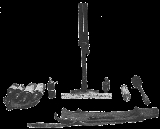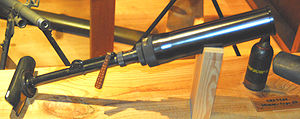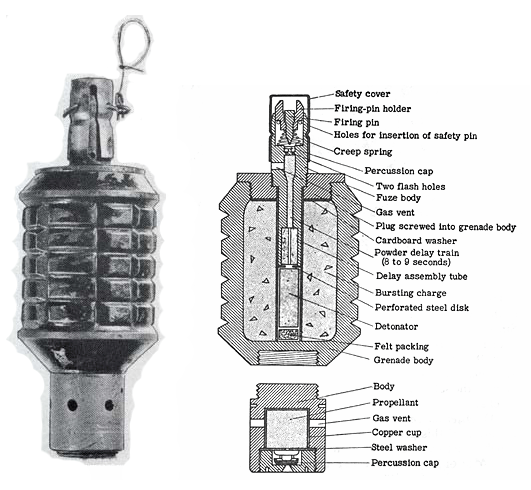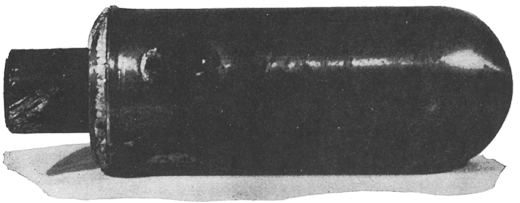
Type 89 Grenade Discharger
Encyclopedia



Japan
Japan is an island nation in East Asia. Located in the Pacific Ocean, it lies to the east of the Sea of Japan, China, North Korea, South Korea and Russia, stretching from the Sea of Okhotsk in the north to the East China Sea and Taiwan in the south...
ese grenade launcher
Grenade launcher
A grenade launcher or grenade discharger is a weapon that launches a grenade with more accuracy, higher velocity, and to greater distances than a soldier could throw it by hand....
or light mortar
Mortar (weapon)
A mortar is an indirect fire weapon that fires explosive projectiles known as bombs at low velocities, short ranges, and high-arcing ballistic trajectories. It is typically muzzle-loading and has a barrel length less than 15 times its caliber....
that was widely used in the Pacific
Pacific War
The Pacific War, also sometimes called the Asia-Pacific War refers broadly to the parts of World War II that took place in the Pacific Ocean, its islands, and in East Asia, then called the Far East...
during the Second World War.
Background
The Japanese Army, noting that grenades were short-ranged weapons, began efforts to optimize these weapons for close-in infantry fighting. After studying employment of grenades and mortars on the battlefield, the Japanese Army developed hand grenadeHand grenade
A hand grenade is any small bomb that can be thrown by hand. Hand grenades are classified into three categories, explosive grenades, chemical and gas grenades. Explosive grenades are the most commonly used in modern warfare, and are designed to detonate after impact or after a set amount of time...
s, rifle grenade
Rifle grenade
A rifle grenade is a grenade that uses a rifle-based launcher to permit a longer effective range than would be possible if the grenade was thrown by hand...
s, and grenade/mortar shell dischargers (small mortars) suited to warfare in typical short-range combat environments such as urban, trench, and jungle warfare.
As part of this effort, the Japanese Army had adopted by 1932 a set of fragmentation grenades with almost universal adaptability. The Type 91
Type 91
Type 91 may refer to:* Type 91 Aircraft * Type 91 Aircraft * Type 91 Aircraft * Type 91 Air-to-Ship Missile* Type 91 Assault Rifle* Type 91 Engine* Type 91 Grenade* Type 91 Grenade Launcher...
fragmentation grenade could be thrown by hand, fired from a spigot-type launcher, or used in a mortar-like grenade discharger, the Type 89.
Design and operation
The Type 89 entered service in 1929, and differs from the earlier Type 10 Grenade DischargerType 10 Grenade Discharger
was a Japanese smoothbore, muzzle loaded weapon used during the Second World War. It first entered service in 1921. The Type 10 has a range of 175 meters, greater than other grenade dischargers of that time. It had a range control device at the base of the barrel in the form of a graduated thimble...
in that it has a rifled barrel. The Type 89 could fire two types of grenades or shells: the Type 91 Grenade
Type 91 Grenade
The was an improved version of the Type 10 fragmentation hand grenade/rifle grenade of the Imperial Japanese Army. Although superseded as a hand-thrown weapon by the Type 97 by the start of World War II it was still used by units in the Second Sino-Japanese War and by reserve forces, as well as...
, which was a normal infantry fragmentation grenade adapted to the Type 89 discharger, and the Type 89 50 mm shell, which was an impact-detonated shell with considerably more explosive power.
When fired from the Type 89 discharger, the Type 91 fragmentation grenade was fitted with a propellant base and time fuse. It did not explode upon contact, but was designed to ignite its fuse while in flight. A weak creep spring inside the grenade firing mechanism allowed the firing pin to be thrown back upon launching, igniting a time fuse with a 7-8 second delay. Using this system, the Type 91 grenades could be launched right through jungle cover or through small openings without the danger of premature detonation in the event the grenade struck an object on its way to the target. Although the Type 89 could be fired by a single person, it was typically operated with a crew of 3, enabling it to reach a rate of fire of about 25 rounds per minute http://www.wlhoward.com/museum/id577.htm.
The Type 89 discharger could also be used with a more powerful impact-detonated shell approaching the power of a light mortar. Weighing approximately two pounds, it was known as the Type 89 50mm shell, and was made in high explosive (HE), incendiary, and smoke variants. To fire the shell (which had a nose-mounted impact fuse that detonated on contact), it was dropped base-down inside the tube of the discharger. By setting the Type 89 discharger at a fixed angle of 45 degrees, and varying distance to target by adjusting the size of a variable chamber space inside the discharger mechanism, Japanese soldiers could adjust fire onto multiple targets at varying ranges while firing the contact-detonated 50 mm shell through a single small clearing in the jungle canopy. The method worked equally well when firing from deep trenches or pits, or between various building obstructions when fighting inside a built-up town or city.
With its curved support plate, the Type 89 was designed to be placed on the ground or against a log or trunk at a fixed firing angle of 45 degrees. However, since it used a spring-loaded, lanyard-operated firing pin mechanism, in an emergency it could fire grenades or shells at point targets while braced horizontally against a tree or building.
Combat use
The Type 89 discharger first saw service in ChinaSecond Sino-Japanese War
The Second Sino-Japanese War was a military conflict fought primarily between the Republic of China and the Empire of Japan. From 1937 to 1941, China fought Japan with some economic help from Germany , the Soviet Union and the United States...
and Manchuria
Battle of Khalkhin Gol
The Battles of Khalkhyn Gol was the decisive engagement of the undeclared Soviet–Japanese Border Wars fought among the Soviet Union, Mongolia and the Empire of Japan in 1939. The conflict was named after the river Khalkhyn Gol, which passes through the battlefield...
. During World War II, the weapon was used in Burma, China, and the Pacific islands. Allied troops soon learned to hit the ground when they heard the telltale 'pop' of the weapon launching its grenades or shells, in some cases from more than 200 yards (183 m) away. Some Allied infantrymen mistakenly assumed that the grenade launcher was propped on the leg to fire and thereafter referred to it as a "knee mortar". However, any soldier or marine who tried to fire a captured Type 89 in this fashion received a severe bruise (and sometimes a broken thigh bone) from the hefty recoil.
The Japanese never designed a shaped-charge or anti-tank warhead for the Type 89 50 mm shell, in retrospect a serious deficiency for an army lacking effective hand-carried infantry anti-tank weapons. As it was, the Type 89 discharger and its ammunition was responsible for many Chinese and later, Allied casualties after the start of World War II.
Ammunition
- Type 89 50mm HE (high explosive) mortar shell (fitted with impact detonator).
- Type 91 Fragmentation Grenade (fitted with 7 second delay time fuse, ignited in flight).
- Type 94 50mm practice shell
- Smoke shell weight: 0.9 kg containing 0.11 kg of HC type smoke mixture.
- Incendiary shell weight: 0.57 kg containing 0.32 of incendiary material.

